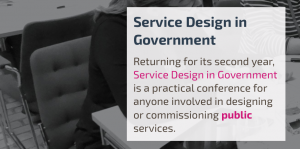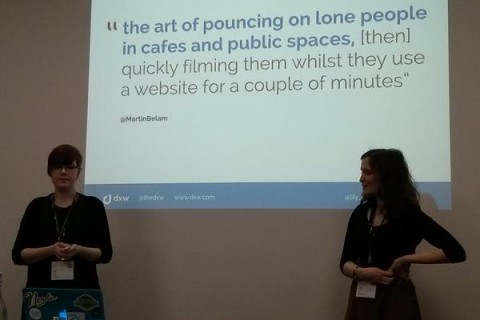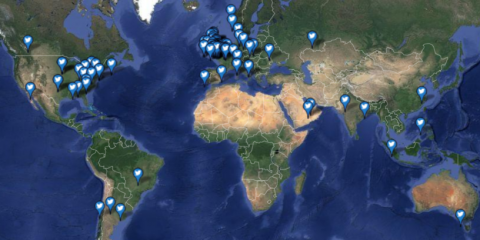A Tale of a Gov Whisperer, Guerrilla User Research and a Free Tool Kit
We recently attended the second incarnation of the Service Design in Government Conference facilitated by the good people at Software Acumen.
So how did the conversation differ from the first event in 2014?
 There was more focus on policy level decision making and the complex systems within which we work. This reflects an evolution in the thinking from last year amongst participants. There was an appreciation that if service design in government is going to become more than just an elite sport, we need to get more people thinking about designing services further upstream in the decision and policy making process.
There was more focus on policy level decision making and the complex systems within which we work. This reflects an evolution in the thinking from last year amongst participants. There was an appreciation that if service design in government is going to become more than just an elite sport, we need to get more people thinking about designing services further upstream in the decision and policy making process.
This was reflected in the two excellent keynote speeches by Andrea Siodmok of the Policy Lab (Cabinet Office) and Alex Maclennan and Jess McMullin reporting on their experiences at the Government of British Columbia which set the scene for both days. Both have recently launched free toolkits – links at the bottom.
What did I learn?
You need a Gov Whisperer…..
Alex and Jess would often be brought into a project at the point when project officers decide they need a bit of software to interact with users. Designing services is more than just designing the IT interface. To provide a well designed service requires improvements in back office processes and procedures, other touchpoints and sometimes changes to policy or legislation. It’s also about changing employees mindsets – they even had a name for this role – the “Gov Whisperer”! Someone who is adept at talking the language of government and working with them to change rather than ‘breaking’ them. In order to do these things effectively in a complex system, it is important to bring service designers in early on in the process – otherwise, they end up unpicking things which prevent the delivery of a smooth and effective service for the end user.
This was also reflected in the excellent case study using Service Design in the sexual health service for Southwark and Lambeth (SH: 24). These wards have the highest incidence of STD’s in the country – people would queue outside clinics on a Monday morning and thousands of people were being turned away from the service every year. The gap between funding and expenditure was growing. Something like Oklahoma city STD testing actually had to be done.
Using service design tools and agile development methodology, they had a new online testing service up and running within 18 weeks. The project was led by Martyn Evans at Unboxed Consulting. Here you can see the live site https://sh24.org.uk/ One of the things that stuck with me when hearing about this successful project was:
25% of the work related to software development;
75% of the work was in changing policy, procedure and mindsets – they met with and answered concerns of the staff in the clinics once a month (the Gov Whisperer at work again!!)
How will I behave differently?
Doing, sharing and pouncing…..
One of the phrases that is resonating with me came from Louis Downe of Government Digital Service. When designing a website, put simply, nouns are bad – verbs are good. The example given was of the service to pay Immigration Health Surcharge (IHS) which is a charge payable by visitors to the UK on a visa longer than 6 months. When using the old website, nobody knew what it was for and it was constantly getting muddled with the NHS. Applying this simple rule, the online screen changed from the “Immigration Health Surcharge (IHS)” to “I need to contribute to the NHS during my stay”. More long winded yes, yet the description fits the way the user will be thinking of the service rather than phrasing it from the governments perspective.
This has impacted on the way I think about our own website and the next iteration of our site will reflect this. It’s also such a simple message, it’s easily shared.
I went to a brilliant  practical workshop “Guerrilla Testing” facilitated by Lily Dart and Rose Rees Jones at DXW. This is useful when you need user feedback on your website yet you have limited budget – an all too common scenario in the public service. It was eloquently described as “The art of pouncing on lone people in cafe’s and public spaces (then) quickly filming them whilst they use a website for a couple of minutes”. The only tools required are a laptop, camera, the inevitable Post-It’s, a printed user scenario and plenty of cake (don’t forget the cake!). I am tempted to rock up in Costa Coffee soon, once we’ve added some verbs to our website and try it out on some unsuspecting coffee drinkers!
practical workshop “Guerrilla Testing” facilitated by Lily Dart and Rose Rees Jones at DXW. This is useful when you need user feedback on your website yet you have limited budget – an all too common scenario in the public service. It was eloquently described as “The art of pouncing on lone people in cafe’s and public spaces (then) quickly filming them whilst they use a website for a couple of minutes”. The only tools required are a laptop, camera, the inevitable Post-It’s, a printed user scenario and plenty of cake (don’t forget the cake!). I am tempted to rock up in Costa Coffee soon, once we’ve added some verbs to our website and try it out on some unsuspecting coffee drinkers!
What held me back?
Nerves…. when presenting our session!
What surprised me?
Journaling questions were a hit……
We facilitated a session at the conference and finished up with a slide showing our Journaling Questions which we suggest people use at the end of each of our workshops – it helps the learning bed in. I was really surprised at how this seemed to resonate with the attendees – my phone didn’t stop buzzing with notifications of retweets. Here is that slide, which you may find useful next time you’re at a learning event. In fact, I’ve used the questions to form this blog.
Really useful set of questions recommended by @reinikainen @Jo_Carter64 for self reflection after any event. #SDinGov pic.twitter.com/NIpRVIncH8
— Phillippa Rose (@phillirose) March 20, 2015
What happened today that gave me a glimpse of the future?
The quality of the conversation since last year has developed from sharing case studies and workshopping tools towards wider consideration of the larger ecosystem and thoughts around policy design (Andrea) and complex systems (Jess and Alex). We have realised that in order to spread the work of service design across government we need to get in earlier and impact further upstream. Next year I’d anticipate hearing some more of the wins at this level.
What frustrated me?
How might we spread the word?……. There are still so many people outside the service design bubble who have never even heard of it. When you see the case studies of the great impact it can have on services and ultimately people’s lives, I feel frustrated that more people aren’t even aware of it. Service design in the commercial world is taking hold and to good effect. Barclays for example employ over 200 service designers, resulting in innovative services such as their recently launched video banking service which allows customers to communicate with staff and carry out transactions on-line or creating delight in their service with personalised debit cards. Barclays don’t do this just because it’s fun, they do it because it gives their business competitive advantage by continuously delighting customers and giving them things they didn’t even know they wanted, yet which make their lives better. The UK is leading the way by hosting this event and getting the world talking about service design in government (the map shows the location of #SDinGov tweets). Over 20 countries were represented at the conference, yet only 2 organisations were from Wales. It feels as though Wales has largely closed its eyes to this really effective way to do more with less – the same applies to open data, responsive technology and agile development. When service failure is one of the biggest costs in government, this is unacceptable and it’s time to catch up. In these times of austerity, why would anyone chose to muddle together a service over designing it? In the long run, I think that the benefits are clear.
so many people outside the service design bubble who have never even heard of it. When you see the case studies of the great impact it can have on services and ultimately people’s lives, I feel frustrated that more people aren’t even aware of it. Service design in the commercial world is taking hold and to good effect. Barclays for example employ over 200 service designers, resulting in innovative services such as their recently launched video banking service which allows customers to communicate with staff and carry out transactions on-line or creating delight in their service with personalised debit cards. Barclays don’t do this just because it’s fun, they do it because it gives their business competitive advantage by continuously delighting customers and giving them things they didn’t even know they wanted, yet which make their lives better. The UK is leading the way by hosting this event and getting the world talking about service design in government (the map shows the location of #SDinGov tweets). Over 20 countries were represented at the conference, yet only 2 organisations were from Wales. It feels as though Wales has largely closed its eyes to this really effective way to do more with less – the same applies to open data, responsive technology and agile development. When service failure is one of the biggest costs in government, this is unacceptable and it’s time to catch up. In these times of austerity, why would anyone chose to muddle together a service over designing it? In the long run, I think that the benefits are clear.
Service failure – one of biggest costs in gov-unnecessary processing; user contact; casework @louisdowne #SDinGov pic.twitter.com/uxrbU1NgFO — Jo Carter (@Jo_Carter64) March 19, 2015
How might we spread the knowledge and skills required within Government – particularly in Wales?
What did I do today that I do every day?
OD’d on caffeine!
What will I do tomorrow?
Run a free event in Wales to share the knowledge……
I’ll be more pro-active in spreading the word regarding service design and other new mental models – particularly amongst public servants in Wales, starting with a blog (start by doing: @UrbanistasCDF!).
As a result of this experience will be running a free event for leaders and senior managers in public services in Wales “New Models for 21st Century Public Services” to share ideas on service design and other new ways of working – click this LINK to register your interest.
If this has whetted your appetite, Policy Lab have just launched a FREE open policy making toolkit which is basically a beginner’s guide to many of the service design tools available. The Government of British Columbia have similarly launched a FREE user experience toolbox.
If you want to hear more, here is a list of excellent case studies where service design has impacted positively, plus another blog:
Transport For London – Every Journey Matters
SH: 24 – Sexual Health 24 hours – the online testing service for Southwark and Lambeth

Pingback: 90% archaeology: my notes and reflections on Service Design in Government 2015 | Matt Edgar writes here